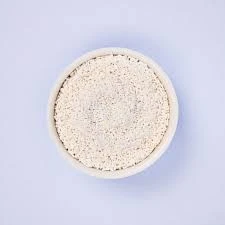
Understanding Food Additive 471 and Its Role in Food Industry Applications
Understanding Food Additive 471 An Overview of Mono- and Diglycerides
Food additives are substances added to food products to enhance flavors, improve preservation, and maintain quality during processing and storage. Among the numerous food additives used in the food industry, one that often raises questions is Food Additive 471, also known as mono- and diglycerides. This article will explore what Food Additive 471 is, its functions, safety considerations, and its presence in everyday food items.
What Are Mono- and Diglycerides?
Mono- and diglycerides are emulsifiers derived from glycerol (a type of alcohol) and fatty acids. These compounds can be naturally occurring or synthetically produced. Typically, they are generated through the process of esterification, where fatty acids are chemically reacted with glycerol. The resulting mono- and diglycerides have one or two fatty acid chains attached to the glycerol molecule, hence their names.
Functions in Food Products
The primary role of Food Additive 471 in food products is to act as an emulsifier. Emulsifiers help to blend ingredients that do not naturally mix well, like oil and water. This property is particularly crucial in products such as margarine, salad dressings, and baked goods, where maintaining a stable mixture is desirable. By stabilizing emulsions, mono- and diglycerides improve the texture and consistency of food products, providing a smoother mouthfeel and preventing separation.
In addition to their emulsifying properties, mono- and diglycerides also serve as anti-staling agents in baked goods, prolonging shelf life and maintaining freshness. They enhance the dough's ability to retain moisture and lead to a softer texture, which is why they are often included in bread and other baked items. Additionally, these additives can contribute to improved dough workability and aid in the production of aeration in cakes and pastries.
food additive 471

Safety and Regulatory Status
The safety of food additives, including mono- and diglycerides, has been evaluated by various regulatory bodies worldwide. In the United States, the Food and Drug Administration (FDA) classifies mono- and diglycerides as Generally Recognized as Safe (GRAS). This designation means that they are considered safe for consumption based on years of use and scientific evidence.
However, it’s essential to note that mono- and diglycerides can be derived from various sources, including plant and animal fats. This variance can pose concerns for those with dietary restrictions. For instance, individuals adhering to a vegan or vegetarian lifestyle may prefer to avoid mono- and diglycerides sourced from animal fats. Therefore, it is advisable for consumers to read ingredient labels carefully, especially if they have specific dietary preferences or requirements.
Common Foods Containing Mono- and Diglycerides
Mono- and diglycerides are prevalent in many processed food items. You can commonly find them in margarine, shortening, baked goods, ice creams, and some snack foods. Their ability to enhance texture and improve shelf life makes them popular among food manufacturers. Additionally, they may be found in non-dairy creamers and certain chocolate products.
Conclusion
Food Additive 471, or mono- and diglycerides, plays a vital role in modern food production by improving the texture and stability of many everyday products. Recognized as safe by regulatory agencies, these emulsifiers also raise considerations regarding their sources, particularly for individuals with dietary restrictions. By understanding what mono- and diglycerides are and how they function, consumers can make informed choices about the food products they consume. In the ever-evolving world of food science and technology, the relevance of additives like Food Additive 471 remains significant, ensuring that the foods we enjoy stay fresh, appealing, and delicious.
-
Buy High-Quality Trichloroisocyanuric Acid for Sale | TCCA 90% SupplierNewsAug.30,2025
-
Pure Sodium Dichloroisocyanurate Dihydrate | Powerful DisinfectantNewsAug.29,2025
-
Industrial Chemicals: Quality & Purity for Every IndustryNewsAug.28,2025
-
Nitrile Rubber Honoring Strict Production StandardsNewsAug.22,2025
-
Aspartame Ingredients Honoring Food Safety ValuesNewsAug.22,2025
-
Fertilizer for Balanced Plant NutritionNewsAug.22,2025
-
Cyanide Gold Processing with High Purity AdditivesNewsAug.22,2025
Hebei Tenger Chemical Technology Co., Ltd. focuses on the chemical industry and is committed to the export service of chemical raw materials.
-

view more DiethanolisopropanolamineIn the ever-growing field of chemical solutions, diethanolisopropanolamine (DEIPA) stands out as a versatile and important compound. Due to its unique chemical structure and properties, DEIPA is of interest to various industries including construction, personal care, and agriculture. -

view more TriisopropanolamineTriisopropanolamine (TIPA) alkanol amine substance, is a kind of alcohol amine compound with amino and alcohol hydroxyl, and because of its molecules contains both amino and hydroxyl. -

view more Tetramethyl Thiuram DisulfideTetramethyl thiuram disulfide, also known as TMTD, is a white to light-yellow powder with a distinct sulfur-like odor. It is soluble in organic solvents such as benzene, acetone, and ethyl acetate, making it highly versatile for use in different formulations. TMTD is known for its excellent vulcanization acceleration properties, which makes it a key ingredient in the production of rubber products. Additionally, it acts as an effective fungicide and bactericide, making it valuable in agricultural applications. Its high purity and stability ensure consistent performance, making it a preferred choice for manufacturers across various industries.





